Introduction to Problem Solving¶
Agenda¶
- Output in Java
- Data Types
- Typecasting
- Input
- Quizzes
- Dashboard Walkthrough
Output in Java¶
Let's start with the famous example - Hello World
Code to Print string/sentence/text¶
public static void main(){
System.out.print("Hello World!");
}
Code to print number¶
public static void main(){
System.out.print(1);
}
Observation¶
- Whenever we print a string, we put double quotes " " around it.
- Double quotes are not required for printing numbers.
Question¶
System.out.print("Hey There");
Choices¶
- Hey There
- "Hey There"
- Error
- "Hey There
Explanation String between "" will get printed. Therefore, solution is Hey There
Question¶
system.out.print(10);
Choices¶
- Error
- 2
- 10
- "10"
Solution There is syntax error in above code. Instead of "system" it should be "System". Error thrown is - "error: package system does not exist"
Question¶
Predict the output:
System.out.print("5 * 10");
Choices¶
- 5 * 10
- "5 * 10"
- 50
- Error
Solution
Prints the sentence / string / charactes between "", so instead of doing calculation & printing 50, we get :-
5 * 10
Output in Java Continued¶
Code to Print Answers to Basic Arithimetic Operations¶
public static void main(){
System.out.print(5 * 10); // gives 50 as output
System.out.print(10 / 5); // gives 2 as output
System.out.print(10 + 5); // gives 15 as output
System.out.print(10 - 5); // gives 5 as output
}
public static void main(){
System.out.println("My name is [instructor]");
System.out.print("I am from [Hometown]");
}
¶
public static void main(){
System.out.println("My name is [instructor]");
System.out.print("I am from [Hometown]");
}
Question¶
System.out.println("This question");
System.out.println("is easy!");
Choices¶
- This question is easy!
- This questionis easy!
- This question
is easy! - This question's easy!
Solution
In first statement println is written hence "This question" gets printed and control goes to new line, then in next line, again println is there, so "is easy!" gets printed and control goes to next line.
Question¶
System.out.println("Red");
System.out.print("Blue ");
System.out.println("Green");
System.out.print("Yellow");
Choices
- Red
Blue Green Yellow - Red
Blue Green
Yellow - Red
BlueGreen
Yellow - Red Blue Green Yellow
Solution
First line has println, so after "Red" gets printed, control goes to new line. Second statement has print, so after "Blue " gets printed, controls stays in the same line Third line has println, so after "Green" gets printed, control goes to new line. Fourth statement has print, so after "Yellow" gets printed, controls stays in the same line
Output in Java Continued¶
- We can do single line comments by ---> //
// single line comment -
We can do multi-line comments by ---> /* */
/* this is a multiline comment */ -
Shortcut to do multi-line comments is to select the part to be commented and press ctrl + /
- We can concatenate two strings like:-
System.out.println("Ram " + "Shayam"); // output: ram shayam and the control will go to the next line
System.out.println("My age is " + 25 ); // output: My age is 25 and the control will go to the next line
Question¶
Predict the output:
System.out.print( 7 + 1 + "156");
Choices¶
- 71156
- 8156
- 1568
- 15617
Question¶
Predict the output:
System.out.print("156" + 7 + 1);
Choices¶
- 1568
- 15678
- 15671
- 1568
Solution
Calculation shall happen from left to right.
For first +, one operand is number and another is string, so it will concatenate them, i.e 1567.
Then for second +, both operands are string, therefore concatenation will happen.
Hence, answer is 15671.
Data types in java¶
Data types¶
-
Primitive Data Types These are predefined in the Java programming language.
For example: byte, short, int, long, double, float, boolean, char -
Non-Primitive Data Types
These are not predefined but defined by the programmer according to the need for a particular task.
For example: String, Arrays, class, etc.
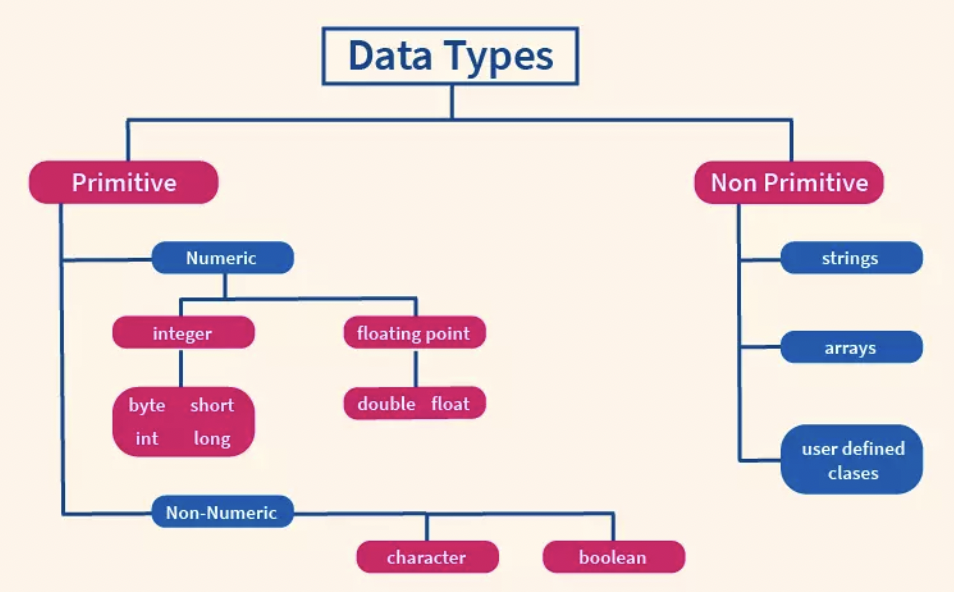
Primitive data types are divided into two different types of values.
- Numeric Data Types
- Non-Numeric Data Types
Numeric Data Types¶
Numeric data types are used to store numeric values such as whole numbers and fractional numbers. They are divided into two parts, integer and floating.
1. Integer
Byte, short, long, and int these data types are used to store whole numbers
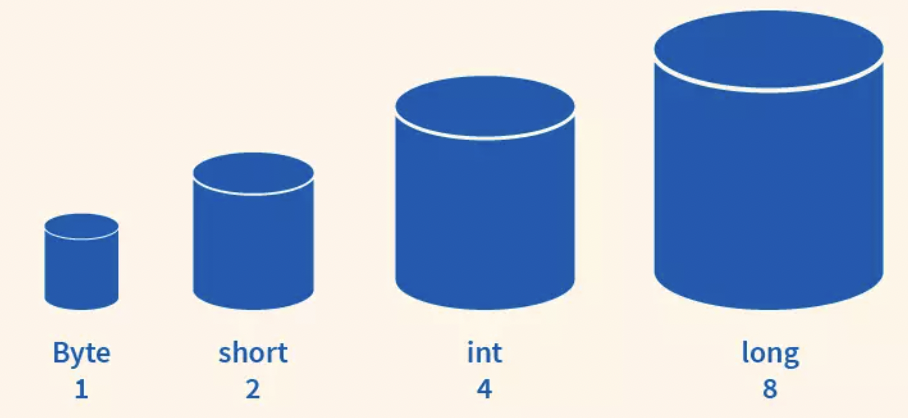
A. Byte Datatype:
It is commonly used when we want to store very small numbers of very limited size. Their data value is in the range of -128 to 127.
byte a = 123;
System.out.print(a); //Printing 123
B. Short Data Type
The short data type can have data values- in the range of -32,768 to 32767.
short a = 123;
System.out.println(a); //Printing 123
C. Int Data Type
The int data type is commonly used when we want to save memory in large arrays. The range is from -2,147,483,648 (-2^31) to 2,147,483,647 (2^31-1).
int a = 123;
System.out.println(a); //Printing the 123
D. Long Data Type
The long data type is used when the int data type cannot handle a wider range than the int data type range. Data values is in the range of -9,223,372,036,854,775,808(-2^61) to 9,223,372,036,854,775,807(2^61 - 1).
long a = 123123123;
System.out.println(a); //Printing the value of a
2. Floating Values Data Types There are two types of Floating values data types in java that are used to store fractional number values.
E. Float Data Type: This data type is used to store numbers that have decimals up to 6 and 7 points.
float a = 1231.231;
System.out.println(a); //Printing the value of a
F. Double Data Type: This data type is used to store numbers that have decimals up to 15 decimals
double a = 12312.23123;
System.out.print(a); //Printing the value of a
We generally use Integer and Long Data Types. Remember their actual range is very tricky. Therefore, we can remember by stating in power of 10.
Close Approximations:¶
Int - { -10^9 to 10^9 }
Long - { -10^18 to 10^18 }
Non Numeric Data Types¶
String
Strings can be created by giving sequence of characters surrounded by double quotes to a variable.
Example:
String S = “This is a String”
Note: We will study non primitive data types later.
Typecasting in java¶
Typecasting¶
- Typecasting is converting one datatype to another.
- We can understand the concept of typecasting by following analogy.
- Let's have two tanks
- one large, with more capacity(say 100ml)
- one small (say 50ml)
- The large tanks corresponds to long datatype and small one corresponds to int datatype.
- Let's see the cases
- Case 1:- If water from smaller tank is poured to larger tank (int to long typecasting).
- In this case the larger tank hold all the water or we can say int can be typecasted to long.
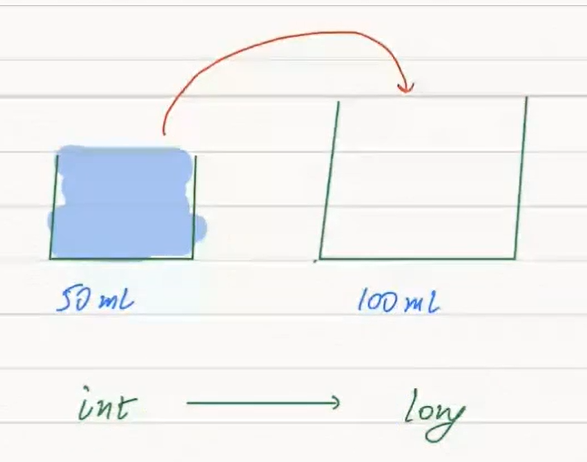
- Case 2:- If larger tank has water <= 50 ml and water from larger tank is poured to smaller tank.
- Since the water in larger tank is equal to smaller tanks capacity the operation can be done.
- We can say that long can be typecasted to int, if the data is within constraints of int datatype value range.
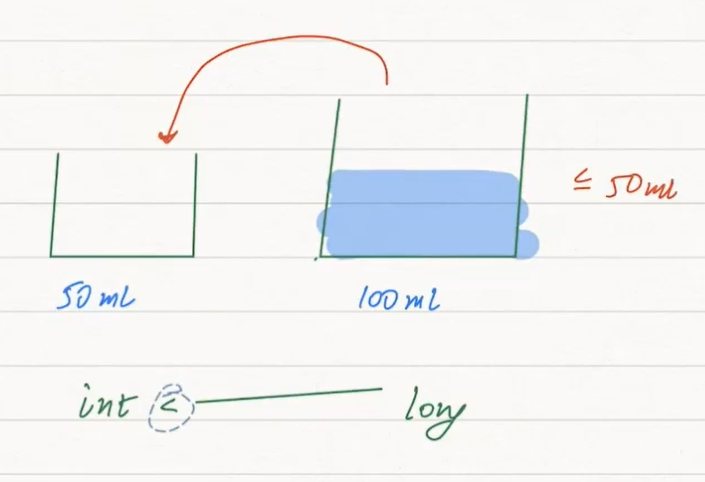
- Case 3:- If larger tank has water > 50 ml and water from larger tank is poured to smaller tank.
- In this case, water will OVERFLOW.
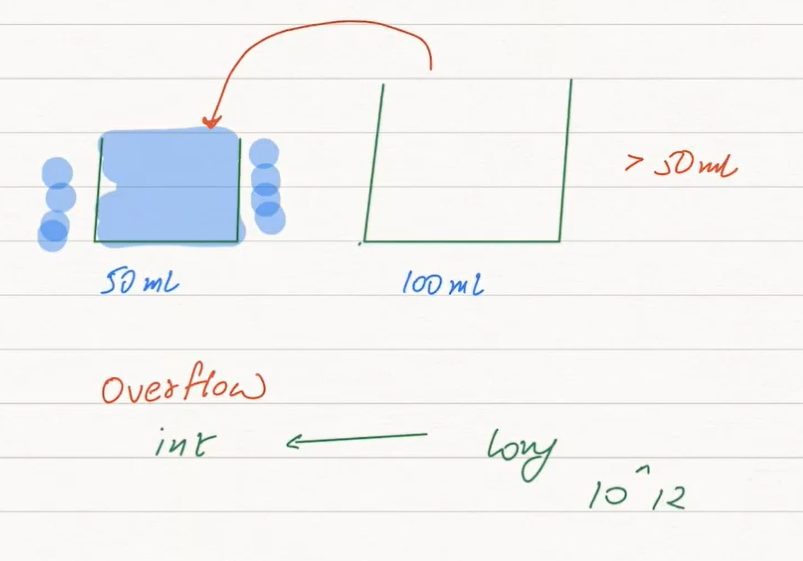
- When long is typecasted to int for data not within constraints of int datatype, the result would be garbage value.
Using variables¶
String name = "arnav"
System.out.print("My name is " + name)
-
We can declare variables as follows:-
int i = 5; long p = 1000000000l; float f = 3.14f; double d = 1.141516171819; -
By default integers are considered int
- By default decimal values are considered double
- Convention of putting l ,f before long and float is only in coding area, not in input
Typecasting example 1¶
// small --> large
int i = 5,
long I = i;
System.out.println(I); // will give 5 as output
Typecasting example 2¶
// large —-> small
long l = 100000000000l
int i = l
System.out.print(i);
- Above conversion will give an error:-Datatypes incompatible possible lossy conversion.
- This type of typecasting is implicit typecasting.
Typecasting example 3¶
// large —> small
long l = 1000l;
int i = l;
System.out.print(i);
- For safety, above conversion will give an error:- Datatypes incompatible possible lossy conversion.
-
We can force the conversion by using explicit typecasting
long l = 1000l; int i = (int)l; // forcing to convert; explicit typecasting System.out.print(i);// 1000 as output -
If we force the same typecasting with data out of int value range
- In above case we would get garbage value.
long l = 10000000000l;
int i = (int)l;
// forcing to convert
// explicit typecasting
System.out.print(i);// garbage value as output
Input in java¶
- Scanner class is used to take inputs in java.
- Following are the methods to take number inputs in java:-
scn = new Scanner(System.in); int i = scn.nextInt(); long t = scn.nextLong(); float f = scn.nextFloat( ) ; double d = scn.nextDouble(); - Following are methods to take string input in java.
//scn. next ( ) —> Reads only 1 word from input String s = scn.next(); System. out. print(s); //scn.nextLine() —> Reads entire line from input String s1 = scn.nextLine(); System.out.print(s1);
Question 1¶
Question¶
Take 2 names X and Y as input and print X loves Y.
Testcase¶
X = Ram
Y = Shyam
Solution¶
Output : Ram loves Shyam
Code¶
String x = scn.next();
String y = scn.next();
System.out.print(x + " loves " + y);
Question 2¶
Question¶
Take name X and age Y as input and print X age is Y.
Testcase¶
X = Aarnav
Y = 25
Solution¶
Output : Aarnav age is 25
Code¶
String x = scn.next();
String y = scn.nextInt();
System.out.print(x + " age is " + y);
